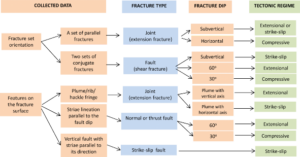3.3 How are Joints, Hybrid Fractures and Faults Recognized on Rock Exposures?
Because joints are perpendicular to σ3, they typically form a set of parallel fractures (Figure 32). Their dip and direction will depend upon the tectonic regime and on the orientation of σ3 (Figure 30). In the Andersonian tectonic regimes, joints can be either horizontal (compressive regime) or vertical (extensional and strike-slip regimes). Plumes and ribs may be present on the surface of joints, and hackle (en echelon smaller fractures with plumes on their surface) may be present at joint fringes (Figure 33 and Figure 34).

Figure 32 – The parallelism of fractures in limestone (a) and in sandstone (b) is evidence of propagation by the opening mode, so these are joint sets. Both are vertical and generated under either a strike-slip or an extensional tectonic regime (photographs: Amélia Fernandes, taken in Colombia (a) and in Brazil (b)).

Figure 33 – Fracture surface features typical of joints (opening mode fractures) from Fossen (2016). a) Plume and arrest lines on an extensional joint in meta-graywacke. The arrest lines (red) resemble ribs and are the loci where propagation was periodically interrupted. The drawing shows the orientation of the stresses in relation to the orientation of the plume axis (based on Dunne & Hancock, 1994). b) Prominent elliptical arrest lines in sandstone. c) Joint (orange color) with hackle fringes (en echelon fractures) in meta-rhyolite. Extension fractures twist (and are arrested) as they reach an interface with a mechanically different rock layer.

Figure 34 – Irregular plume on a joint surface in granite. The rock is un-weathered and there is an ocher coating on the joint surface from iron oxide precipitation. The approximately horizontal axis of the plume indicates that the joint was formed in a strike-slip regime (photograph: Bruna Fiume).
Shear and hybrid fractures typically form two sets of conjugate fractures (Figure 35 and Figure 36a), with an angle of approximately 60° for the former and less than 45° for the latter (Figure 16 and Figure 18). In addition, striae lineation and the respective perpendicular steps, which are used as indication of the movement sense (Petit, 1987), are frequently observed on fault and shear fracture surfaces (Figure 36b, Figure 37). Hybrid fractures may bear fainter striae lineation and plumes on the same surface. Under the Andersonian tectonic regimes, the dip of faults may be around 60° (extensional regime), 30° (compressive regime) and vertical (strike-slip regime) (Figure 30). Striae lineation is parallel to the dip in the first two cases (Figure 37a,c) and parallel to the direction in the latter (Figure 37b).

Figure 35 – Typical pattern of shear fractures. a) Conjugate fractures (red lines in the inset drawing) and bedding-parallel fractures (dashed black lines) in a low-grade-metamorphism fine sandstone. b) A detail of part a. The exposure is subhorizontal and the conjugate fractures are subvertical, and are therefore generated in the strike-slip tectonic regime. Region of Capitólio, Minas Gerais, Brazil (photograph: Amélia Fernandes).

Figure 36 – Typical pattern of shear fractures. a) Pattern of hybrid conjugate fractures forming an acute angle of 45o; Abitibi region, Québec, Canada. The conjugate fractures are subvertical, therefore generated in the strike-slip tectonic regime (photographs: Amélia Fernandes). b) Surface of a subvertical fault in massive granite, in Campinas, São Paulo, Brazil (Fernandes & Amaral, 2002). The oblique striae lineation (parallel to the red dashed line) along with steps (approximately parallel to the dashed white line) on one side of the quartz infilling stripes (grey color) is a good visual indicator of the sense of movement. In this case, the movement is dextral or right-hand (the missing block moves toward the observer). The fault is subvertical, which is typical of the strike-slip tectonic regime, and the dip of the striae lineation indicates oblique movement (horizontal and vertical components).

Figure 37 – Typical pattern of shear fractures. a) A small fault in Miocene mudstone, in Campinas, São Paulo, Brazil. The fault dip, around 60o, and the striae lineation, parallel to the fault dip, indicate that this is a normal fault formed under the extensional tectonic regime. b) Subvertical fault (in granite) with subhorizontal striae lineation, implying a strike-slip tectonic regime; little steps transversal to the striae lineation are used as indication of the movement sense. c) Fault in gneiss dipping around 30o, with striae lineation parallel to its dip; these characteristics are consistent with a thrust fault generated under a compressive tectonic regime (photographs: Amélia Fernandes).
The fracture type and the tectonic Andersonian regimes are deduced from data collected in the field regarding fracture patterns (parallel or conjugate), fracture dip, striae lineation orientation and features present on the fracture surfaces (plumes or striae). A flowchart showing the type of data collected from rock exposures, and the corresponding interpretation of the fracture type and tectonic regime, is given in Figure 38.

Figure 38 – The fracture type and the tectonic Andersonian regimes are deduced from the data collected from rock exposures regarding fracture patterns (parallel or conjugate), fracture dip, striae lineation orientation and features present on the fracture surfaces (plumes or striae).
